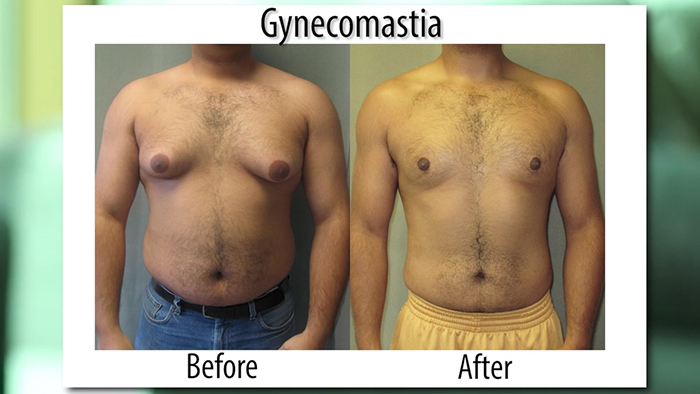Rarely discussed although acutely apparent, Gynecomastia (male breasts) is actually quite common—affecting 40-60% of men. It is characterized by an excess of fat and/or breast glandular tissue in the chest area. In men experiencing considerable weight loss, the cause is may be obvious, but for those within normal weight range it has been linked to drug side effects, heredity, or certain medical conditions. In most cases the cause is unknown.
Not only can gynecomastia cause men to be dissatisfied with their physical appearance, but it can lead to bigger problems like lack of confidence, embarrassment, and even discomfort during certain physical activities. Dr. James Namnoum from Atlanta wants to spread the word that there is no reason to live with the shame of “man boobs”- and there are many men who are unaware of the options available to correct it. “Gynecomastia is very anxiety provoking because it is difficult to hide,” says Namnoum. “It’s feminizing, strikes a dagger at the heart of masculinity…and it is easily fixed.”
by Isabel Bolt
and James Namnoum, MD
Who is Affected?
If you are embarrassed or self-conscious about your chest, you are in good company. The 2015 statistics published by the American Society of Aesthetic Plastic Surgeons reports that gynecomastia is the 4th most popular cosmetic surgery for men with over 30,500 cases last year. The percentages are astonishing: male breast reduction for the treatment of gynecomastia has risen by 173% since ASAPS initiated its survey in 1997, rising 26% in the past year alone.
There is a common misconception that gynecomastia only affects men who are overweight, when in fact, it occurs in men of all age groups, all body shapes, and all weight ranges. Even athletes who are in top physical and muscular shape can suffer from this condition, and may require male breast reduction surgery.
In actuality, gynecomastia is experienced by the majority of adolescents between 12 and 17 years old. In these cases, breast buds may last up to two years but tend to go away within six to twelve months. Dr. Namnoum explains this is due to hormones happening in a young man’s development. “Because of the surge of androgens, breast buds occur in probably 90% of pre-teens and teens. Obesity in youth is a problem because fat cells convert androgen to estrogen. This condition corrects itself in most cases as hormones level out, and pubescent weight is lost.”
Once a young man reaches his late teens and early 20’s the breasts usually flatten. However, if the breasts are persistent, surgical intervention may be necessary to correct the condition. Conversely, says Dr. Namnoum, the vast majority of men past 50 have breasts. “It’s a combination of fat, fibrous tissue and breast tissue. I have seen men in consultation that have C cups. The reality is, men have bad habits–eating and drinking too much, and not exercising enough. Even if they do lose weight, the breasts may not go away.” In addition, one of the lesser known causes is testosterone, which is separated from estrogen by only one molecule, so the “high T” many men seek may also contribute to the problem.
When to Seek Help
Because gynecomastia can affect men of all ages for many different reasons, there is no right or wrong age for surgery to be performed. In some cases, particularly those of younger patients, the condition is temporary and eventually resolves itself. Moreover, some doctors do believe that there may be a possibility of recurrence if surgery is performed at too young an age. In general, male breast reduction surgery is considered if gynecomastia has been present for two or more years and is stable and has not increased in size. However, every patient is unique, and the decision to operate is based not only on the individual causes of the patient’s conditions but also on the maturity of the patient, his capability of understanding the surgery, and his ability to cope with the post-op recovery. While there is no definitive upper age limit for surgery to correct gynecomastia, older patients should understand that, in some rare cases, the skin may not completely re-tighten after the surgery, as some skin elasticity may have been lost due to the natural process of aging.
The Procedure
Dr. Namnoum explains gynecomastia is a fairly simple procedure. The surgical technique will depend upon whether your condition is primarily comprised of excess glandular tissue or fatty tissue. “For young men, there might be just a small disc of breast tissue to remove. For others, a combination of liposuction (for contour) and direct removal of tissue is a very effective treatment. A small incision is made at the edge of the areola. Eventually you don’t even see it.” Since the procedure removes fat and /or glandular tissue from the breasts, the result is a chest that is flatter, firmer and better delineated. In more extreme cases, excess skin is also removed. “Men with excess skin and tissue can have a breast reduction,” explains Namnoum. “I suction out the fat and remove the redundant skin and tissue, then lift and tighten the remaining tissue. The size of the scar is dependent upon the severity of the condition. In a breast reduction, there is a trade-off between accepting a scar in order to achieve a desired shape and flatness.”
A Return of Confidence
A flatter, more defined chest as well as flatter and smaller nipples and areola are evident within weeks of the procedure. Dr. Namnoum sees relieved, happy patients at their post-op visit. “The thing that affected their self-image and caused such embarrassment and anxiety is gone,” he says. “They’re boating, swimming, wearing tight t-shirts…the younger men are playing sports and going into the locker room for the first time without apprehension.” Dr. Namnoum also counsels those considering gynecomastia to go straight to a board certified plastic surgeon instead of a pediatrician, family physician or general surgeon. “We are accustomed to diagnosing this condition and applying the correct treatment for the best aesthetic outcome. There is no point in having something so correctable affect your confidence.”

















Facebook
Twitter
Instagram
YouTube
RSS